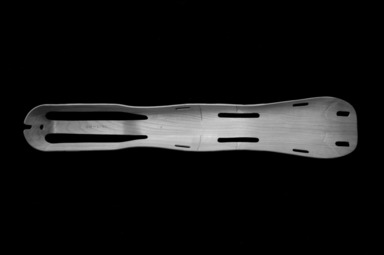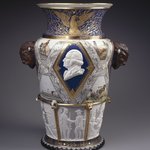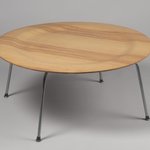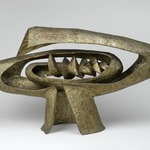Leg Splint
Decorative Arts and Design
On View: Decorative Art, 20th-Century Decorative Arts, 4th Floor
Called by the U.S. Navy during World War II to create a lightweight, inexpensive leg splint for injured personnel, the California designers Charles and Ray Eames employed molded plywood to produce a functional yet sculptural form that informed their later furniture designs.
MEDIUM
Plywood
DATES
designed 1941–1942; manufactured 1943–1945
DIMENSIONS
42 x 4 1/4 x 8 in. (106.7 x 10.8 x 20.3 cm)
(show scale)
MARKINGS
Branded on inside section behind ankle: "S2-1790"; stamped in green on outside near top: "MOLDED PLYWOOD DIVISION / LOS ANGELES CALIFORNIA / patent pending [...] EAMES [...]"; circular logo containing "EVANS PRODUCTS COMPANY" around circle, and crisscrossing in center: "EVANS / EVANS"
SIGNATURE
no signature
INSCRIPTIONS
no inscriptions
ACCESSION NUMBER
83.156
CREDIT LINE
Anonymous gift
CATALOGUE DESCRIPTION
Long piece of plywood molded to the human leg, flaring out at the top to fit against the buttocks and tapering in at the bottom to support the lower leg and foot. Numerous rectangular cut-out sections to allow for ties to secure leg to splint.
CONDITION: Good. No finishing solution was applied to surface. Some splits in surface due to normal production.
CAPTION
Charles Eames (American, 1907–1978). Leg Splint, designed 1941–1942; manufactured 1943–1945. Plywood, 42 x 4 1/4 x 8 in. (106.7 x 10.8 x 20.3 cm). Brooklyn Museum, Anonymous gift, 83.156. Creative Commons-BY (Photo: Brooklyn Museum, 83.156_view2_bw.jpg)
IMAGE
overall, 83.156_view2_bw.jpg. Brooklyn Museum photograph
"CUR" at the beginning of an image file name means that the image was created by a curatorial staff member. These study images may be digital point-and-shoot photographs, when we don\'t yet have high-quality studio photography, or they may be scans of older negatives, slides, or photographic prints, providing historical documentation of the object.
RIGHTS STATEMENT
Creative Commons-BY
You may download and use Brooklyn Museum images of this three-dimensional work in accordance with a
Creative Commons license. Fair use, as understood under the United States Copyright Act, may also apply.
Please include caption information from this page and credit the Brooklyn Museum. If you need a high resolution file, please fill out our online
application form (charges apply).
For further information about copyright, we recommend resources at the
United States Library of Congress,
Cornell University,
Copyright and Cultural Institutions: Guidelines for U.S. Libraries, Archives, and Museums, and
Copyright Watch.
For more information about the Museum's rights project, including how rights types are assigned, please see our
blog posts on copyright.
If you have any information regarding this work and rights to it, please contact
copyright@brooklynmuseum.org.
RECORD COMPLETENESS
Not every record you will find here is complete. More information is available for some works than for others, and some entries have been updated more recently. Records are frequently reviewed and revised, and
we welcome any additional information you might have.








































